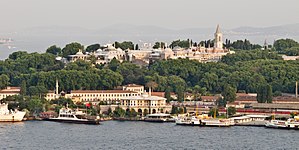Topkapı Sarayı
Saray-ı Hümayun, Saray-ı Cedide-i Amire olarak da bilinir.
- Tür: Müze, Saray
- Tema: Topkapı Sarayı
- Kültür: Osmanlı
- Yüzyıl: 15. yy
- Bölge: Türkiye, Marmara Bölgesi, İstanbul, Fatih, Cankurtaran
| Topkapı Palace | |
|---|---|
 View of the Topkapı Palace from the Golden Horn | |
 | |
| General information | |
| Type |
|
| Architectural style | Ottoman, Baroque |
| Location | Istanbul, Turkey |
| Coordinates | 41°0′46.8″N 28°59′2.4″E / 41.013000°N 28.984000°E |
| Construction started | 1459 |
| Completed | 1465 |
| Client | Ottoman sultans |
| Owner | Turkish state |
| Technical details | |
| Structural system | Various low buildings surrounding courtyards, pavilions and gardens |
| Size | 59,260 to 70,000 m2 (637,900 to 753,500 sq ft) |
| Design and construction | |
| Architect(s) | Mehmed II, Alaüddin, Davud Ağa, Mimar Sinan, Sarkis Balyan[1] |
| Website | |
| Part of | Historic Areas of Istanbul |
| Criteria | Cultural: i, ii, iii, iv |
| Reference | 356 |
| Inscription | 1985 (9th Session) |
The Topkapı Palace (Turkish: Topkapı Sarayı;[2] Ottoman Turkish: طوپقپو سرايى, romanized: ṭopḳapu sarāyı, lit. 'cannon gate palace'),[3] or the Seraglio,[4] is a large museum and library in the east of the Fatih district of Istanbul in Turkey. From the 1460s to the completion of Dolmabahçe Palace in 1856, it served as the administrative center of the Ottoman Empire, and was the main residence of its sultans.
Construction, ordered by the Sultan Mehmed the Conqueror, began in 1459, six years after the conquest of Constantinople. Topkapı was originally called the "New Palace" (Yeni Saray or Saray-ı Cedîd-i Âmire) to distinguish it from the Old Palace (Eski Saray or Sarây-ı Atîk-i Âmire) in Beyazıt Square. It was given the name Topkapı, meaning Cannon Gate, in the 19th century.[5] The complex expanded over the centuries, with major renovations after the 1509 earthquake and the 1665 fire. The palace complex consists of four main courtyards and many smaller buildings. Female members of the Sultan's family lived in the harem, and leading state officials, including the Grand Vizier, held meetings in the Imperial Council building.
After the 17th century, Topkapı gradually lost its importance. The sultans of that period preferred to spend more time in their new palaces along the Bosphorus.[citation needed] In 1856 Sultan Abdulmejid I decided to move the court to the newly built Dolmabahçe Palace. Topkapı retained some of its functions, including the imperial treasury, library and mint.
After the end of the Ottoman Empire in 1923, a government decree dated April 3, 1924 transformed Topkapı into a museum. Turkey's Ministry of Culture and Tourism now administers the Topkapı Palace Museum. The palace complex has hundreds of rooms and chambers, but only the most important are accessible to the public as of 2020[update], including the Ottoman Imperial Harem and the treasury, called hazine where the Spoonmaker's Diamond and the Topkapi Dagger are on display. The museum collection also includes Ottoman clothing, weapons, armor, miniatures, religious relics, and illuminated manuscripts such as the Topkapi manuscript. Officials of the ministry as well as armed guards of the Turkish military guard the complex. The Topkapı Palace forms a part the Historic Areas of Istanbul, a group of sites in Istanbul that UNESCO recognised as a World Heritage Site in 1985.[6]
- ^ director; Batur, editor Afife (2006). Historic peninsula. Istanbul: Chamber of Architects of Turkey Istanbul Metropolitan Branch. pp. 65–6. ISBN 9753958994.
{{cite book}}:|first2=has generic name (help) - ^ Pronounced Turkish pronunciation: [ˈtopkapɯ saɾaˈjɯ].
- ^ Necipoğlu, Gülru (1991). Architecture, Ceremonial, and Power: The Topkapı Palace in the Fifteenth and Sixteenth Centuries. Cambridge: MIT Press. pp. 278 (Plate 13). ISBN 0-262-14050-0.
- ^ "Topkapi Palace Museum - museum, Istanbul, Turkey". Archived from the original on 24 February 2021.
- ^ "Top Capou (i.e. Top Kapı), Constantinople, Turkey". World Digital Library. 1890–1900. Retrieved 2013-10-20.
- ^ ICOMOS (2006). "2006 Periodic Reporting" (PDF). State of Conservation of World Heritage Properties in Europe SECTION II. UNESCO. Retrieved 2008-09-17.

